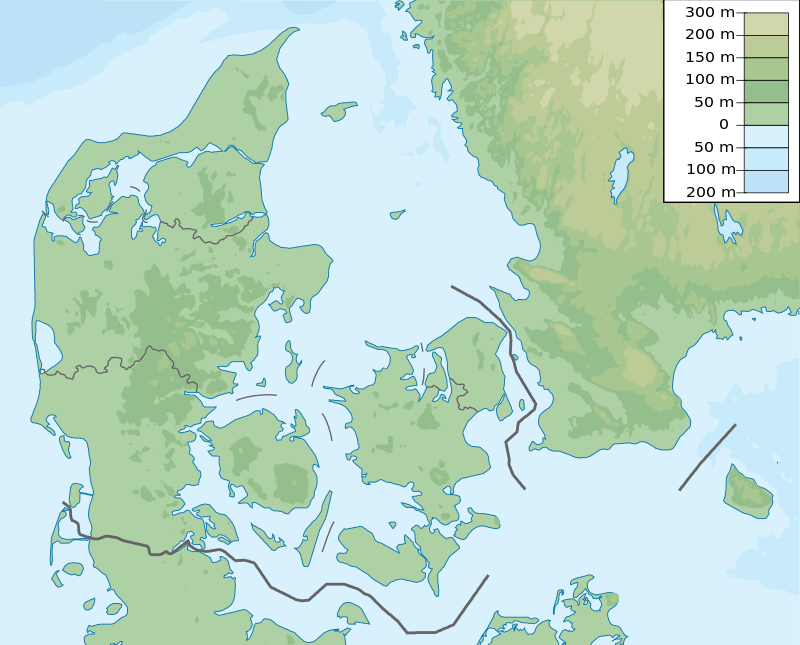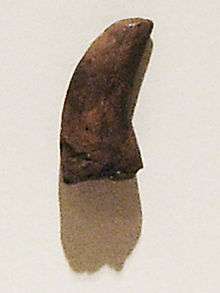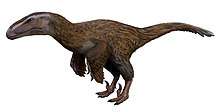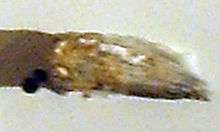Jydegaard Formation
The Jydegaard Formation (also spelled as 'Jydegård') is a geological formation dating to the Early Cretaceous, about 145-139 million years ago. It is on the island of Bornholm, Denmark. Vertebrate fossils have been found in the formation.[1]
| Jydegaard Formation Stratigraphic range: Late Berriasian-early Valanginian ~145–139 Ma | |
|---|---|
| Type | Geological formation |
| Unit of | Nyker Group |
| Sub-units | Rødbjerg & Tornhøj Members |
| Underlies | Arnager Greensand Formation |
| Overlies | Robbedale Formation |
| Lithology | |
| Primary | Claystone, sandstone |
| Location | |
| Coordinates | 55.1°N 14.8°E |
| Approximate paleocoordinates | 47.2°N 21.4°E |
| Region | Bornholm |
| Country | |
 Jydegaard Formation (Denmark) | |
Fossil content
Thin bone fragments have been uncovered that may belong to pterosaurs or birds.[1]
Dinosaurs
A tooth possibly belonging to a juvenile titanosaur has been found in the formation.[1]
| Genus | Species | Location | Material | Description | Images |
|---|---|---|---|---|---|
|
D. bornholmensis[1] |
Two teeth and possible coprolites.[2] |
 Holotype tooth  Life Reconstruction | |||
Crocodylomorphs
| Genus | Species | Location | Material | Description | Images |
|---|---|---|---|---|---|
|
unknown |
Robbedale[1] |
A tooth tentatively referred to Pholidosaurus[3] |
 Possible tooth | ||
Fish
Fish remains have been found in coprolites possibly belonging to the dromaeosaur Dromaeosauroides or marine turtles. Also, unidentified pycnodont jaws and two small stem-teleosteans have been uncovered. Amioid scales have also been revealed.[1]
| Genus | Species | Location | Material | Description | Images |
|---|---|---|---|---|---|
|
L. sp[1] |
Robbedale[1] |
Teeth, jaws and scales[1] |
|||
|
unknown |
Robbedale[2] |
Teeth and scales[2] |
|||
|
Parvodus[1] |
P. rugianus[4] |
Robbedale[1] |
Teeth, finspines and head "hooks"[1] |
||
|
P. serrata[5] |
Robbedale[1] |
unknown |
|||
Bivalves
| Genus | Species | Location | Material | Description | Images |
|---|---|---|---|---|---|
|
Neomiodon[1] |
unknown |
Robbedale[1] |
many specimens[1] |
Neomiodon specimens are thought to be victim to a mass mortality such as poisoning.[1] |
|
|
unknown |
Robbedale[1] |
many specimens[1] |
Viviparus specimens are thought to be victim to a mass mortality such as poisoning.[1] |
||
Color key
|
Notes Uncertain or tentative taxa are in small text; |
References
- Bonde, N.; Cristiansen, P. (2003). "New dinosaurs from Denmark". Comptes Rendus Palevol. 2 (13). doi:10.1016/51631-0683(03)00009-5.
- Milàn, J.; Rasmussen, B. W.; Bonde, N. (2012). "Coprolites with prey remains from the Lower Cretaceous (Late Berriasian) Jydegaard Formation of Bornholm, Denmark" (PDF). New Mexico Museum of Natural History and Science. Bulletin. 57: 235–240.
- Schwarz-Wings, D.; Rees, J.; Lindgren, J. (2009). "Lower Cretaceous Mesoeucrocodylians from Scandinavia (Denmark and Sweden)". Cretaceous Research. 30 (5): 1345. doi:10.1016/j.cretres.2009.07.011.
- "Parvodus rugianus". Paleobiology Database. Retrieved 25 September 2013.
- "Pleuropholis serrata". Paleobiology Database. Retrieved 25 September 2013.
Further reading
- J. Rees. 2000. An Early Cretaceous scincomorph lizard dentary from Bornholm, Denmark. Bulletin of the Geological Society of Denmark 48:105-109